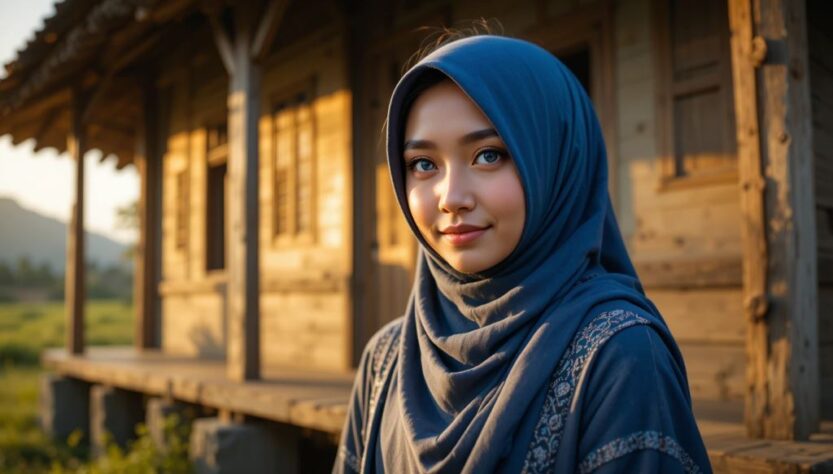If you travel about one and a half hours from Banda Aceh to the west, you will see a coastal area called Lamno, Aceh Jaya Regency. The sea is turquoise, the sand is soft white, and the air is still fresh without the hustle and bustle of the city. But natural beauty is not the only thing that amazes here. There is another uniqueness that makes Lamno called “blue-eyed village”.
Among the people with thick Acehnese accents and polite Muslim clothing, occasionally you can see faces with fair white skin, sharp noses and clear blue eyes. They are not foreign tourists, but “Bule Lamno” a term for residents of Portuguese descent who have been rooted in Aceh for more than five centuries.
Historical Traces from the Indian Ocean
This story begins around the 16th century, when Portuguese ships sailed to the waters west of Aceh. A number of colonial records state that Portuguese sailors landed on the coast of Lamno, partly because they were trading spices, partly because their ship was sunk in a storm.
From this unplanned meeting, a love story across continents was born. The European sailors who survived married Acehnese women, converted to Islam, and lived according to local customs. From this marriage emerged a generation of Acehnese who inherited the European blue gene, an anthropological phenomenon unique to the archipelago. “They are no longer foreigners, but part of the Acehnese people who firmly maintain their traditions and religion,” said Pak Malik (57), a Lamno traditional elder.

Genetically, this phenomenon can be explained by the inheritance of recessive genes for blue eyes and light skin. According to population genetics research, if two individuals carry the same gene—even if it has been mixed with local genes for several generations—the possibility of having a blue-eyed child remains. In Lamno, this is clearly visible. A number of children are still born with ocean blue eyes or faint blonde hair. A symbol that the Portuguese footprint in Aceh is not just a historical record, but also lives in human DNA.
Royal Blood and “Cut” Title
Interestingly, many of the Portuguese descendants in Lamno have ties to Acehnese noble families. In oral history, it is stated that some Portuguese sailors married the daughters of uleebalang or regional heads. Because of this, to this day some of their descendants hold the title “Cut”, the title of Acehnese female nobility.
Cut Riana (29), one of the descendants who still has faint blue eyes, said,
“My great-grandfather, Cut Sarah, was said to be a descendant of Raja Daya who married a Portuguese. His face was Caucasian, but he still wore traditional Acehnese clothes and prayed in the meunasah.” The integration of these two cultures has transformed into a new identity: an Aceh that is open but still rooted in Islamic values and customs.
Tsunami and the Loss of Traces of Generations
However, the devastating tsunami waves in December 2004 were a big blow to this community. Villages on the coast of Lamno, inhabited by hundreds of families of Portuguese descent, were destroyed. Field data records that out of around 300 families, only around 30 families managed to survive. Many of them now live in Banda Aceh and Lhokseumawe.
Mr. Amiruddin, the local imam, recalled, “Many of those blue-eyed faces disappeared with the waves. But their stories live on in the hearts of the Lamno people.”
Today, physical traces of Portuguese ancestry are increasingly diminishing due to mixed marriages. However, socially and culturally, the memory of “Bule Lamno” is still firmly embedded in the collective memory of the community.
Beauty that is more than just physical
The media often highlights the face of “foreigners from Lamno” as local exoticism. In fact, their uniqueness is not only in the color of their eyes or skin, but in the strength of culture and faith that is passed down across generations.
Their distinctive characteristics are not simply European descent, but firmness in customs and religion, perseverance in maintaining their ancestral rubber and patchouli plantations, and pride as true Acehnese. Even though they look like Europeans, Lamno residents of Portuguese descent adhere to Islamic values and Acehnese customs. They work together in meunasah (Surau), holding a birthday feast, and dancing the Saman in traditional events.
Maria (24), a blue-eyed girl from Lamno, admitted that she had been teased at school because of her appearance. However, his grandmother’s advice made him proud of that identity.
“Grandma said, this is a gift from God. Proof that Aceh was once a meeting place for great nations,” he said smiling.
The story of the Caucasian Lamno reminds us that Indonesia is a great mosaic of civilizations meeting. There, Portuguese blood, the heart of Aceh, and the soul of Islam blend harmoniously. A tsunami may hit, genes may fade, but the story of a Portuguese sailor who became an Acehnese farmer lives on as a symbol of inclusiveness and resilience of Indonesian culture.
As the Lamno proverb has been passed down from generation to generation: “Our eyes may be different colors, but the blood that flows remains the same — the unyielding blood of Aceh.”
Cover
Come to Lamno not only to take photos with blue-eyed girls, but to hear long stories about love, history and identity. Because behind the color of their eyes, there is an important lesson about how “the stranger” can become “us”. Or, as a poetic sentence was once adapted from Sapardi Djoko Damono: “Lamno is not just about blue eyes, but about how history dances in human genes.”
Also Read: Planting Faith in Mud and Peat: The Green Revolution of Aceh’s Salafi Dayahs
Author: Hanif, Academy and Improving Literacy
News
Berita
News Flash
Blog
Technology
Sports
Sport
Football
Tips
Finance
Berita Terkini
Berita Terbaru
Berita Kekinian
News
Berita Terkini
Olahraga
Pasang Internet Myrepublic
Jasa Import China
Jasa Import Door to Door
